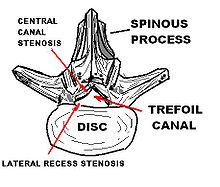| Lumbar spinal stenosis | |
|---|---|
| Other names | wear and tear in the spine |
 | |
| Lumbar vertebra showing central stenosis and lateral recess stenosis. | |
| Specialty | Orthopedics |
| Symptoms | Pain, numbness, or weakness in the low back, buttocks, or legs typically worsened with prolonged walking or standing and relieved with sitting or lying down |
| Usual onset | Gradual (months to years) |
| Types | Congenital, acquired |
| Causes | Narrowed spinal cord due to spinal degeneration or abnormal anatomy |
| Diagnostic method | Clinical (a combination of history, physical examination, and imaging) |
| Differential diagnosis | Claudication from peripheral artery disease |
| Treatment | Medication, physiotherapy, injections, surgery |
Lumbar spinal stenosis (LSS) is a medical condition in which the spinal canal narrows and compresses the nerves and blood vessels at the level of the lumbar vertebrae. Spinal stenosis may also affect the cervical or thoracic region, in which case it is known as cervical spinal stenosis or thoracic spinal stenosis. Lumbar spinal stenosis can cause pain in the low back or buttocks, abnormal sensations, and the absence of sensation (numbness) in the legs, thighs, feet, or buttocks, or loss of bladder and bowel control.
The precise cause of LSS is unclear. Narrowing of spinal structures in the spinal cord such as the central canal, the lateral recesses, or the intervertebral foramen (the opening where a spinal nerve root passes) must be present, but are not sufficient to cause LSS alone.[1] Many people who undergo MRI imaging are found to have such changes but have no symptoms.[1] These changes are commonly seen in people who have spinal degeneration that occurs with aging (e.g., spinal disc herniation). LSS may also be caused by osteophytes, osteoporosis, a tumor, trauma, or various skeletal dysplasias, such as with pseudoachondroplasia and achondroplasia.
Medical professionals may clinically diagnose lumbar spinal stenosis using a combination of a thorough medical history, physical examination, and imaging (CT or MRI).[1] EMG may be helpful if the diagnosis is unclear.[1] Useful clues that support a diagnosis of LSS are age; radiating leg pain that worsens with prolonged standing or walking (neurogenic claudication) and is relieved by sitting, lying down, or bending forward at the waist; and a wide stance when walking.[1] Other helpful clues may include objective weakness or decreased sensation in the legs, decreased reflexes in the legs, and balance difficulties, all of which are strongly associated with LSS.[1] Most people with LSS qualify for initial conservative non-operative treatment. Nonsurgical treatments include medications, physiotherapy, and injection procedures.[1] Decompressive spinal surgery may modestly improve outcomes but carries greater risk than conservative treatment.[1] Overall, there is limited supporting evidence to determine the most effective surgical or nonsurgical treatment for people with symptomatic LSS.[1] Evidence to support the use of acupuncture is also limited.[1]
Lumbar spinal stenosis is a common condition and causes substantial morbidity and disability. It is the most common reason people over the age of 65 pursue spinal surgery.[1] The condition affects over 200,000 people in the United States.[1]